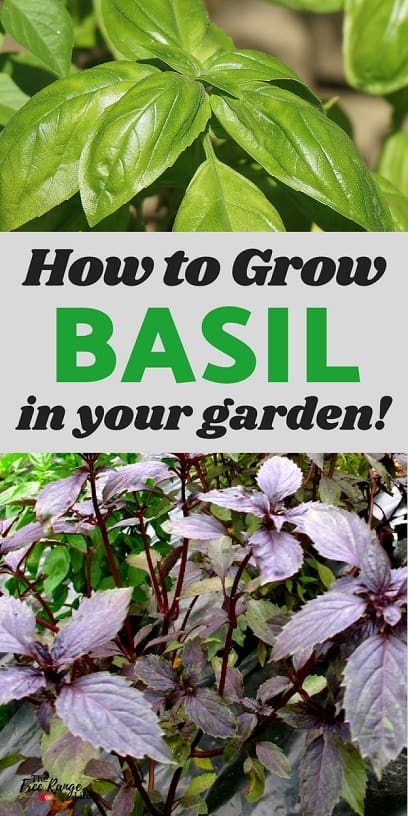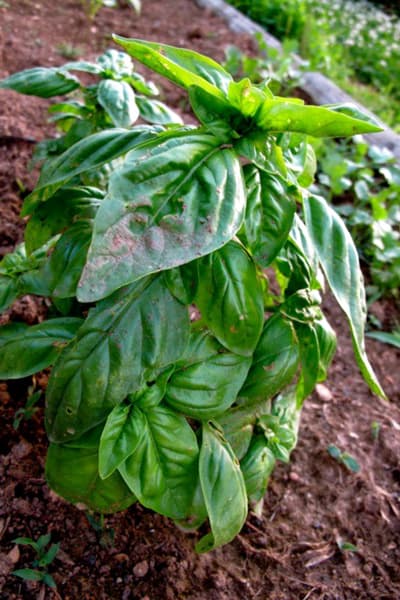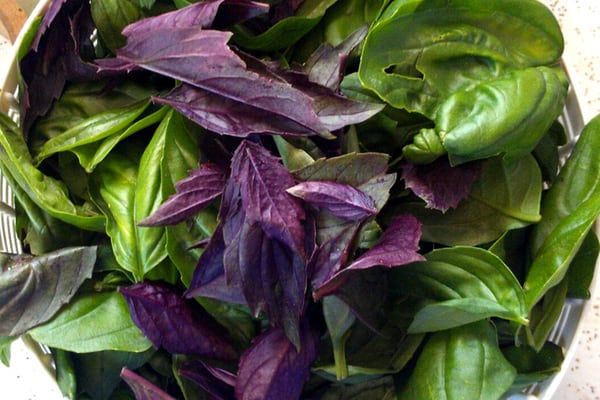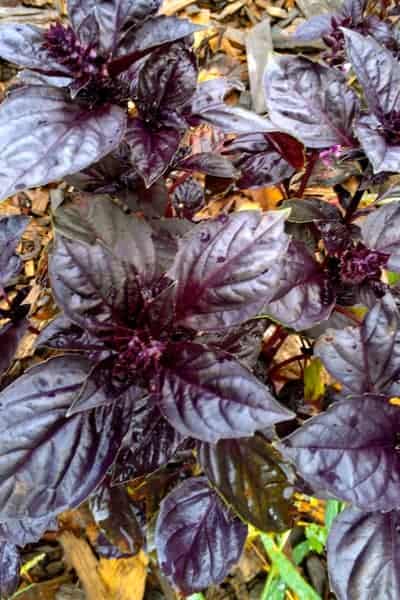Basil is probably one of the most common herbs grow in backyard vegetable gardens. And for good reason! Growing basil has a ton of uses- from making amazing pesto to pairing well with tomatoes in both the garden and in dishes.
Growing basil is super easy, and it keeps on producing all season long- giving you plenty to eat and preserve! Keep reading for tips on how to grow basil, how to harvest, how to preserve and some of my favorite basil varieties to grow.
This site contains affiliate links. If you make a purchase using one of these links, I may earn a commission. Please see my disclosure page for more information about cookies collected and our privacy policy.
How to Grow Basil (from Seed!)
Basil is an easy plant to grow from seed, and it’s best to start it indoors about 6-8 weeks before your last frost date.
The basil seeds should be planted into a seed-starting soil or potting mix and covered very lightly with about 1/4 of an inch of soil. Keep the soil moist at all times to ensure germination. Your seeds should sprout in about 5 days.
Your basil seedlings will need to be kept under grow lights or in a sunny location indoors until the weather has warmed enough to plant.
When daytime temperatures are warm and your basil seedlings have at least a couple of true leaves you can move your seedlings outside for a few hours a day to get acclimated to the sun and wind. This process is known as hardening off- and is an important step to take before transplanting to the garden.
When all threat of frost has past it is time to transplant your basil in your garden. Choose a spot that in the full sun, though basil will grow in partial shade. Your location should receive a minimum of 6 hours of sun per day. Plant your basil plants about 12-18 inches apart in well drained soil.
Basil need lots of water, so be sure to water during dry periods and mulch to help conserve and prevent water loss.
Basil is also perfect for growing aeroponically in a container like a Tower Garden. These amazing towers are perfect for herbs and greens- and can help you grow in a smaller space, indoors, or during all seasons.
How to Care and Harvest Your Growing Basil
Basil will grow quite fast once the weather is warm. And your tiny seedlings will soon be big bushy plants!
Pinching off the growing tips (the top 2 sets of tiny leaves) will help create a bushy plant with more stems and leaves. Once your plants are about 6 inches tall you can start regular prunings and harvests! When it comes to pruning, don’t be shy! Your basil will keep growing back, better than ever with regular pruning.
Here are a couple tips on pruning your basil plants:
Prune your basil plants regularly, once a month at least.
Cut off the top 2/3rds of the basil plant. Don’t worry- the remaining plant will be big and bushy again in a matter of weeks!
Give them a chance to rest in between. You can still pick leaves for soups or salads, but save things like pesto or drying for after big harvests.
Pinch off any flowers or buds you see on your plants. Regular harvests should keep flowers away, but any you miss, pinch off to keep the flavor in the leaves stronger.
These big harvests keep your basil plants healthy and allow you to harvest all season long.
Basil also makes a great companion for many other plants in your garden. Learn more about what to pair basil with: The Best Basil Companion Plants.
How to Preserve Basil After Harvest
Basil grows well inside, so if you want fresh basil all year long, you can keep a pot of basil in your kitchen window even during the winter.
You can also preserve basil easily by either drying or freezing.
Like most herbs, drying basil is fairly simple. I like to tie bunches together and hang them upside down inside until completely dry. Basil has a high water content so it can a few days to a week to dry completely.
Using a dehydrator (read all about the best dehydrators) is helpful in drying your basil completely so that it won’t mold. Once dry store your basil in an air tight container- like a mason jar! You can get the complete instruction on drying basil here: How to Dry Basil in 2 Ways.
You can also freeze basil by:
- Placing your basil in olive oil and freezing
- Pressing basil leaves into ice cube trays or other containers, filling with water, then freezing.
- Spreading your basil leaves on a tray and flash freezing them before transferring to a freezer bag or container.
- Making pesto and freezing
Here’s more on preserving basil: 10 Ways to Preserve Basil at Home
Best Basil Varieties to Grow in Your Garden
There are a ton of basil varieties out there. A lot more than your average sweet basil. Here are a couple basil varieties to try this year:
Genovese Basil: An Italian heirloom basil with large leaves. This basil is fast growing and gives high yields. It’s great for fresh eating and cooking.
Corsican Basil: A Mediterranean basil with leaves mottled in green and purple. This purple basil has a strong, aromatic flavor that makes a great pesto!
Siam Queen Basil: This is a Thai basil with a strong, clove-like scent. Benefits from afternoon shade in hotter climates. Great for stir-fry, curries, or other Thai cuisines.
Lemon Basil: A lemon scented basil. Can be added to lemonade or seafood dishes for amazing additional flavors. Try adding some to your pesto recipe too!
Lettuce Leaf Basil: A Japanese basil with HUGE 3-5 inch leaves. Has a strong anise flavor.
Cinnamon Basil: A cinnamon scented basil that makes a wonderful tea or infused oil. Can be used in some recipes to replace cinnamon.







Have been trying to grow basil in Arizona for 20 yrs. Starts off well but leaves gradually become 1/2 original size. It is watered, pruned , but sill not bushy.
You might want to add extra mulch, because your state is so warm the water evaporates quickly and doesn’t get into the plants. I use the tomato water rule (5 gallons per plant per week).
Where can I find seeds for those certain basil flavors you mentioned?
Look on amazon…there are free catalogs you can ask for on YouTube to to order seeds…there are Facebook groups you can join that do seed exchanges/trading seeds…or buying. You can ask at some local nurseries and if they don’t have them maybe they can tell you where you can purchase them.
I live in south Florida. When I put my basil inside my patio that is screened I do not have a problem with bugs. However, when I put my basil outside bugs eat it and it’s ruined within days after planting. What natural organic pesticide do you recommend to put on my basil to keep the bugs from eating it. Thank you